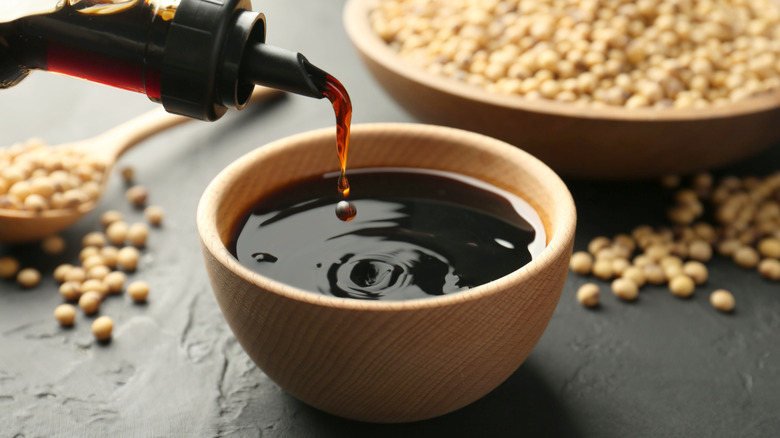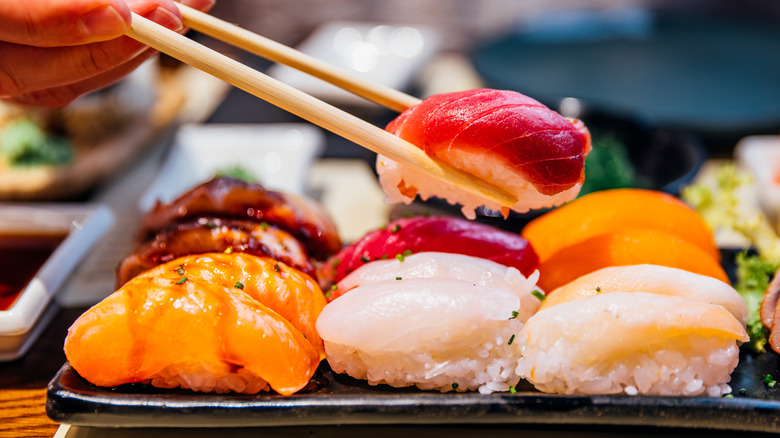Avoid This Common Mistake With Soy Sauce While Eating In Japan
Japan has been surging in popularity as a global destination, and one look at this dynamic East Asian country will tell you why. After all, the Land of the Rising Sun is a fascinating archipelago made up of volcanic peaks, rugged coastline, idyllic countryside, and some of the most vibrant, kinetic cities on earth. Japan has it all — scenery, culture, and a long, intriguing history — so it's no wonder people are flocking there in droves, and when you do go, make sure to hit these unmissable destinations outside of the capital.
Of course visiting Japan doesn't come without a few minor pitfalls. While locals are invariably helpful and polite, Japan is a society governed by a number of unwritten and unspoken rules — like the proper etiquette when visiting an onsen — that are important to know and attempt to follow if you want to be a considerate tourist.
This is especially true when it's time to eat, which should happen a lot during any trip to Japan, since indulging in its sublime cuisine is one of the highlights of any visit. That said, try to not forget some basics: Never leave your chopsticks sticking upright in the bowl of rice, always pour others' drinks instead of your own, and wherever you're dining, do not douse your plain white rice in soy sauce.
An easy faux pas to avoid
Soy sauce is central to both the Japanese kitchen and table. It is said to have been accidentally invented in the town of Kishu Yuasa in 1254 by the zen priest Kakushin, and since then it has become an indispensable part of the national cuisine. It's hard to imagine sitting down to a meal in Japan without soy sauce as an ingredient or condiment.
That said, there are some does and don'ts regarding its usage. First off, it's largely considered gauche (and even disrespectful) to pour soy sauce onto plain white rice. It conveys the message that the meal as a whole lacks flavor. It can also come across as ill-mannered, since — for better or worse — such a practice is associated with lack of education and poverty. It's kind of like putting sugar in your wine or applying ketchup on pizza in Italy. It's generally not done — at least for adults. That said, like with a lot of rules in Japan, the locals are likely to give foreigners a bit of a pass, especially in areas with a lot of tourists.
White rice is served with meals in Japan precisely because of its neutrality. It's the perfect vessel for soaking up flavor, so it's best to pair it with the most pungent or savory dishes on the table. Take your white rice with a bite salty fish, pickled veggies, or — if you're sitting down for a proper Japanese breakfast — a nice blast of natto, the fermented soybean concoction that is beloved throughout the nation (but can be a bit much for Western palates).
Don't drown your sushi, either
You also may wish to reexamine how (or if) you apply soy sauce next time you find yourself at a sushi restaurant in say, Tokyo or Osaka. Some chefs take umbrage when customers dip the whole piece of sushi in the plate of sauce, especially if the rice ball begins to fall apart and little grains are left behind, floating sadly like fallen soldiers.
In some higher-end establishments, chefs will often brush a bit of soy sauce onto the piece, rendering the need to add more irrelevant. When in doubt, ask the person preparing the meal, and if you must dip, just gently — and briefly — lower the very tip of the piece of sushi into the sauce before delivering it into your anxiously-waiting mouth.
You may also be eating your sushi incorrectly. While not an iron-clad rule, many chefs appreciate it when customers place the piece in their mouths fish-side down. This guarantees that their guests taste the fish first, which, after all, is the most important part of the combo. The soft, vinegar-soaked rice is then bitten into afterwards, a perfect, pillowy compliment to the explosion of flavor that comes with that first contact with your tuna, mackerel, sea bream, or other sweet and briny pleasures from the deep. While you're eating your way around Japan, make sure to stop off at this culinary gem of a city.


